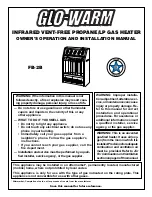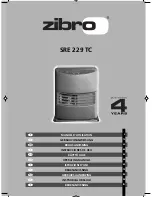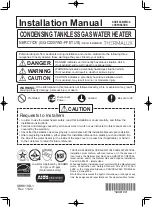
11
GI-IM048En-1013
1. DIRECT VENT INSTALLATION OF EXHAUST VENT AND INTAKE PIPE
If installing a direct vent option, combustion air must be drawn from the outdoors directly into the water heater intake, and exhaust must
terminate outside. There are three basic direct vent options detailed in this manual:
1. Side Wall Venting
2. Roof Venting
3. Unbalanced Venting
Be sure to locate the heater such that the exhaust vent and intake piping can be routed through the building and properly terminated.
Different vent terminals can be used to simplify and eliminate multiple penetrations in the building structure (refer to the Venting
Section). The exhaust vent and intake piping lengths, routing and termination methods must all comply with the methods and limits
given in the Venting section, Part 5 of this manual.
When installing a combustion air intake from outdoors, care must be taken to utilize uncontaminated combustion air.
To prevent
combustion air contamination, see Table 1
: Contaminant Table
.
2. INDOOR COMBUSTION AIR INSTALLATION IN CONFINED OR UNCONFINED SPACE
This heater requires fresh, uncontaminated air for safe operation and must be installed in a mechanical room where there is adequate
combustion and ventilating air.
NOTE: To prevent combustion air contamination, see Table 1
: Contaminant Table
.
Combustion air from the indoor space can be used if the space has adequate area or when air is provided through a duct or louver to
supply sufficient combustion air based on the water heater input.
Never obstruct the supply of combustion air to the water heater.
If the water heater is installed in areas where indoor air is contaminated (see Table 1) it is imperative that the water heater be installed
as direct vent so that all combustion air is taken directly from the outdoors into the water heater intake connection.
Unconfined space
is space with volume greater than 50 cubic feet per 1,000 Btu/hour (4.8 cubic meters per kW) of the total input
rating of all fuel-burning appliances installed in that space. Rooms connected directly to this space, through openings not furnished with
doors, are considered part of the space. See
Figure
, p. 36 for details.
Confined space
is space with volume less than 50 cubic feet per 1,000 Btu/hour (4.8 cubic meters per kW) of the total input rating of
all fuel-burning appliances installed in that space. Rooms connected directly to this space, through openings not furnished with doors,
are considered part of the space.
When drawing combustion air from inside a conventionally constructed building to a confined space, such space should be provided
with two permanent openings: one located 6” (15 cm) below the space ceiling, the other 6” (15 cm) above the space floor. Each
opening should have a free area of one square inch per 1,000 Btu/hr (22 cm
2
/kW) of the total input of all appliances in the space, but
not less than 100 square inches (645 cm
2
).
If the confined space is within a building of tight construction, air for combustion must be obtained from the outdoors as outlined in the
Venting section, Part 5 of this manual.
When drawing combustion air from the outside into the mechanical room, care must be taken to provide adequate freeze protection.
Do not attempt to vent this water heater by any means other than those described in this manual. Doing so will void the warranty, and
may result in severe personal injury or death.
Failure to provide an adequate supply of fresh combustion air can cause poisonous flue gases to enter living space, resulting in severe
personal injury or death.
To prevent combustion air contamination, see Table 1
.
F. PREVENT COMBUSTION AIR CONTAMINATION
Install intake piping for the heater as described in the Venting Section. Do not terminate exhaust in locations that can allow
contamination of intake air.
Ensure that the intake air will not contain any of the contaminants below. Contaminated air will damage the heater, resulting in possible
substantial property damage, severe personal injury, or death. For example, do not pipe intake near a swimming pool. Also, avoid areas
subject to exhaust fumes from laundry facilities. These areas always contain contaminants.
Summary of Contents for UGC120S-100
Page 36: ...36 GI IM048En 1013 Figure 18 LP LP ...
Page 39: ...39 GI IM048En 1013 D INTERNAL WIRING DIAGRAM Figure 21 Wiring Diagram LP ...
Page 40: ...40 GI IM048En 1013 Figure 22 LP 179 L LP ...
Page 49: ...49 GI IM048En 1013 Figure 26 LP 179 J LP ...
Page 50: ...50 GI IM048En 1013 Figure 27 LP 179 H LP ...












































